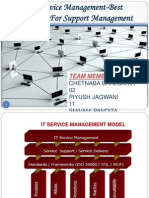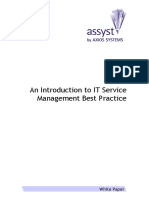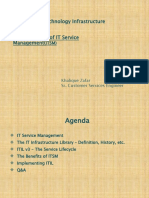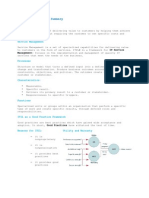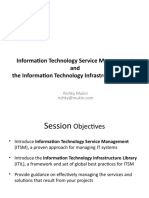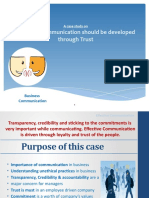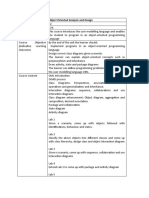Itil (Information Technology Infrastructure Library) - Systematic Approach To High Quality
Uploaded by
Xtine RamosItil (Information Technology Infrastructure Library) - Systematic Approach To High Quality
Uploaded by
Xtine RamosExamples of outcomes:
- Make airline reservations online
- Pay-at-the-pump gas transactions
- Register students for classes
Example of constraints:
- Insufficient CPU capacity
- Skills shortage
INTRODUCTION
ITIL
(Information Technology
Infrastructure Library)
- Systematic approach to high quality
IT service delivery having documented
best practice for IT Service
Management
Developed in 1980s by what is now
The Office of Government
Commerce (OGC)
itSMF (IT Service Management
Forum) - involved in maintaining best
practice documentation in ITIL
CHAPTER 1
Service Management as a Practice
Service - a means of delivering value
to customers by facilitating outcomes
customers want to achieve without the
ownership of specific costs and risks
Outcomes are possible from the
performance of tasks and are limited
by the presence of certain
constraints.
Service Management is a set of
specialized organizational capabilities
for providing value to customers in the
form of services
Capability transforms Resources into
a valuable service.
Resources are the building blocks of
services
Service Management maximizes
organizational capabilities and
minimizes the effect of constraints
Function - team or group of people
and the tools they use to carry out one
or more processes or activities
Role - set of responsibilities, activities
and authorities granted to a person or
team
Process - set of activities designed to
accomplish a specific objective.
-takes defined inputs and turns them
into defined outputs.
-may include roles, responsibilities,
tools and management controls
required to deliver the outputs
EXAMPLES
Restoring service Incident
Mgmt
Problem solving Problem
Mgmt
Managing changes Change
Mgmt
Releasing software Release
Mgmt
What is a Service?
A means of facilitating outcomes
desired by customers
Service Transition
Service Operation
Continual Service
Improvement
ITIL V.2 - ITIL V.3: Key Differences
ITIL V.2
o Process-based approach
o 8 books
Service Delivery
Service Support
Business Perspective
Planning
to
Implement
Service
Management
ICT
Infrastructure
Management
Application
Management
Software Asset
Management
Security Management
What is Service Management?
A set of specialized organizational
capabilities providing value to
customers in the form of services
What is the difference between a
role and a function?
A function provides the resources and
tools needed to execute processes and
activities while a role defines
responsibilities and authorities
CHAPTER 2
The Service Lifecycle
ITIL V.3
Life Cycle - The complete cycle of
events occurring over the lifetime of
an animate or inanimate object
o Lifecycle-based approach
o 5 books
Service Strategy
Service Design
Service Transition
Service Operation
Continual Service
Improvement
Example: Human lifecycle (simplified)
Conception
Childhood
Adulthood
Death
Service Life Cycle - The architecture
of the ITIL core is based on a lifecycle
approach
Service Life Cycle
Service Strategy
Service Design
ITIL can be used together with these
to achieve better alignment with the
business, higher quality services, as
well as compliance where necessary.
ITIL V.3 three major components:
Core books
Complementary guides
Website
Service Strategy (SS)
Shows organizations how to
transform Service Management into
a strategic asset and to then think and
act in a strategic manner
Helps clarify the relationships
between various services, systems or
processes and the business models,
strategies or objectives they support
Financial Management
Demand Management
Service Portfolio Management
o Service Pipeline
o Service Catalog
o Retired Services
Strategy Generation
Service Design (SD)
Provides guidance for the design and
development of services and Service
Management processes
The scope includes new services, and
the changes and improvements
necessary to increase or maintain
value to customers over the lifecycle
of services
Service Level Management
Service Catalog Management
Availability Management
Capacity Management
Supplier Management
Information Security Management
IT Service Continuity Management
Service Transition (ST)
Plan and implement the deployment
of all releases to create a new service
or improve an existing service
It also manages any data, information,
and knowledge needed to manage IT
services.
Transition Planning and Support
Change Management
Configuration Management
Release Management
Service Validation and Testing
Evaluation
Knowledge Management
Management and coordination of
processes, systems and functions to:
Package, build, test and deploy a
release into production
Service Operation (SO)
Coordinate and carry-out day-to-day
activities and processes to deliver
and manage services at agreed levels
Ongoing management of the
technology that is used to deliver and
support services
Where the plans, designs and
optimizations are executed and
measured
Event Management
Incident Management
Request Fulfillment
Problem Management
Achieving balance
(Conflicting Motives)
IT Services vs Technology
Stability vs Responsiveness
Quality of service vs Cost of service
Reactive vs Proactive
The value of communication
Good communication is needed
between all ITSM personnel and
with users/customers/partners
All communication should have:
Intended purpose and/or resultant
action
Clear audience, who should be
involved in deciding the need/format
Accountable for a particular service:
-
Initiation and transition
Ongoing maintenance and
support
Monitoring and reporting
Identifying improvement
opportunities
Continual Service Improvement
(CSI)
-
Aims to continually align IT
services to changing business
needs by identifying and
implementing improvements
Service Measurement
Service Reporting
Service Improvement
RACI Model
- can be used to help define roles and
responsibilities
-
Complacency is the single biggest
enemy of continual improvement
Key Principles, Models, and
Concepts
Service Provider - An organization
supplying services to one or more
internal customers or external
customers
Process Owner
Responsible for:
-
Assisting with Process Design
Documenting the process
Making sure the process is
being performed as
documented
Making sure the process meets
its aims
Monitoring and improving the
process over time
Service Owner
Responsible The person or
people responsible for getting
the job done
Accountable Only one
person can be accountable for
each task
Consulted The people who
are consulted and whose
opinions are sought
Informed The people who
are kept up-to-date on progress
Suppliers and Contracts
Supplier - A third party responsible
for supplying goods or services. These
are required by the service provider to
enable them to deliver services
Contract - A legally binding
agreement between two or more
parties to supply goods or services
Risk Management and Analysis
-
Risk Management - control
Risk Analysis identification
Plan, Do, Check, Act Model
(Deming Cycle)
Plan Plan service management &
services
Do Implement & run service
management& service
Check Monitor, measure & review
Act Make Modifications
Governance
demands corporate fairness
mandates transaction
transparency
holds executives
accountable
Corporate Governance - Ensures
the provision of a corporate strategy
and business plan. Establishes the
corporate policies and enables the
strategic direction, objectives, critical
success targets and key results areas.
Corporate Compliance - Assures
adherence to legal, industrial and
regulatory requirements.
IT Governance - Establishes IT
policy, standards and principles and
assures alignment of IT strategy to
corporate business strategy.
IT Compliance - Assures the design
and operability of IT policies,
processes and key controls.
IT Service Management Establishes, enables and executes
the IT strategy. Establishes and
operational model to assure highquality, compliant IT service
provisions. Ensures effective key result
areas.
Which of the following is not
within the scope of development
for Service Design?
Release and deployment planning
When transitioning a new service
into a production environment,
which of the following activities
should be considered?
Evaluate process maturity and
integration
What are the three elements of a
service portfolio?
Service pipeline, service catalog,
retired services
Which of the following statements
is INCORRECT regarding risk
analysis and risk management?
Risk Management is responsible for
security, availability and IT service
continuity within an organization
Continual Service Improvement
Purpose: to continually align and
realign IT services to changing
business needs by identifying and
implementing improvements to IT
services that support business
Processes
CSI is about looking for ways to
improve Process effectiveness and
efficiency, as well as costeffectiveness
Main Objectives:
to review, analyse and make
recommendations on improvement
opportunities
to review and analyse Service Level
Achievement results;
to identify and implement individual
activities
to improve cost-effectiveness of
delivering IT services without
sacrificing customer satisfaction;
to ensure applicable quality
management methods are used
Measuring and reporting
performance against targets of
an end-to-end service
Combines component
measurements to provide a view
of customer experience
Data can be analyzed over time
to produce a trend
Data can be collected at multiple
levels (for example, CIs,
processes, services)
CSI and Organizational Change
Successful CSI supports
organizational change
Organizational change presents
challenges
Use formal approaches to
address people-related issues:
-
John Kotters Eight steps to
transforming your organization
Project Management
John Kotters Eight steps to
transforming your organization
1.
2.
3.
4.
5.
Create a sense of urgency
Form a guiding coalition
Create a vision
Communicate the vision
Empower others to act on the
vision
6. Plan for and create quick wins
7. Consolidate improvements and
produce more Changes
8. Institutionalize the Change
Key point: Take baseline(s) before
implementing improvements
Why do we measure?
Types of Metrics
Deming Cycle
W. Edwards Deming
four key stages of the cycle are Plan,
Do, Check and Act
critical at two points in CSI:
1.implementation of CSIs
2. application of CSI to services and
service management processes
CSI : Service Measurement
To validate
To Intervene
To Justify
To Direct
Technology - typically components
and applicable
Example : Performance, Availability
Process - Critical Success Factors
(CSFs), Key Performance Indicators
(KPIs), activity metrics for ITSM
processes
-help determine the overall health of
a process
Service - end-to-end service metrics
Critical Success Factors (CSF)
Something that must happen if a
Process, Project, Plan, or IT Service is
to succeed.
Key Performance Indicator (KPI)- A
Metric that is used to help manage a
Process, IT Service or Activity.
--only the most important of these are
defined as KPIs and used to actively
manage and report on the Process, IT
Service or Activity
--selected to ensure that Efficiency,
Effectiveness, and Cost Effectiveness
are all managed.
--used to measure the achievements
of each CCSF
Qualitative example:
CSF: Improving IT service quality
KPI: 10 percent increase in customer
satisfaction rating for handling
incidents over the next 6 months.
Time spent on the incident by
second-level operative and their
average salary
Time spent on Problem
Management activities by second-level
operative and their average salary
Time spent on the training
first-level operative on the workaround
Cost of a service call to thirdparty vendor
Metrics required:
ITIL V3 Service Improvement
Original customer satisfaction score
for handling incidents
Time and material from third-party
vendor.
Ending customer satisfaction score
for handling incidents.
The 7 Step Improvement Process
Purpose:
Measurements:
Measurement is essential for
Continual Service Improvement
The 7 Step Improvement Process is
designed to provide this
measurement
Incident handling survey score
Number of survey scores.
Quantitative example:
CSF: Reducing IT costs
7 Steps
1.
2.
3.
4.
5.
6.
7.
KPI: 10 percent reduction in the costs
of handling printer incidents.
Metrics required:
Original cost of handling a
printer incidents
Final cost of handling a printer
incidents
Should
Can
Gather
Process
Analyze
Present
Implement
From Vision to Measure
Cost of the improvement
Measure-Metrics-KPI-CSF-ObjectivesGoals-Mission-Vision
Measurements:
Continual Service Improvement
Manager
effort.
Time spent on the incident by
first-level operative and their average
salary
Roles:
Accountable for the success of all
improvement activities
Communicates the CSI vision
across the IT organization
Defines and reports on CSI Critical
Success Factors, Key Performance
Indicators and CSI activity metrics
Co-ordinates CSI throughout the
service lifecycle
Builds effective relationships with
the business and IT managers
Ensures monitoring is in place to
gather data
Works with process and service
owners to identify improvements
and improve quality
Service Manager
Roles:
Manages the development,
implementation, evaluation and
on-going management of new and
existing products and services
Develops business case, product
line strategy and architecture
Develops new service deployment
and lifecycle management
schedules
Performs Service Cost
Management activities
Works to instill a market focus
This role is very similar to the
"Product Manager" role in Service
Strategy
ITIL V3 REVIEW
Service-Delivers value to customer by
facilitating outcomes customers want
to achieve without ownership of the
specific costs and risks
Service Level-Measured and reported
achievement against one or more
service level targets
Example :
Red = 1 hour response 24/7
Amber = 4 hour response 8/5
Green = Next business day
Service Level Agreement-Written
and negotiated agreement between
Service Provider and Customer
documenting agreed service levels
and costs
Configuration Management
System (CMS)
Tools and databases to manage IT
service providers configuration
data
Contains Configuration
Management Database (CMDB)
Configuration Management
Database (CMDB)
Records hardware, software,
documentation and anything else
important to IT provision
Release - Collection of hardware,
software, documentation, processes or
other things require to implement one
or more approved changes to IT
Services
Data Data and Information Layer
Information Information Integration
Layer
Knowledge Knowledge Processing
Layer
Wisdom Presentation Layer
Incident-Unplanned interruption to an
IT service or an unplanned reduction in
its quality
Workaround -Reducing or eliminating
the impact of an incident without
resolving it
Problem-Unknown underlying cause
of one or more incidents
Known Error-A problem that has a
documented root cause and a
Workaround.
4Ps of Service Management
People skills, training,
communication
Processes actions, activities,
changes, goals
Products tools, monitor, measure,
improve
Partners specialist suppliers
Service Delivery Strategies
Service Strategy
4Ps of Service Strategy
Perspective where service strategy
is articulated as mission/vision
Position-where service strategy is
expressed in a specific way that
allows comparison
Plan where ss is asked as a
question
Pattern - ss is a consistent set of
activities to be performed
4 Activities of Service Strategy
Define the market
Develop offerings
Develop strategic assets
Prepare for execution
-used to help the IT Service Provider
understand and plan for different
levels of business activity
SS: Service Assets
RESOURCES
Things you buy or pay for
IT Infrastructure, people, money
Tangible Assets
Example: Hardware & Software,
People, Buildings, Tools, Cash
CAPABILITIES
Things you grow
Ability to carry out an activity
Intangible assets
Transform resources into
Services
Example: Processes, Functions,
Specialized workflow, Competency
Service Strategy: Service Portfolio
Management
-Prioritizes and manages investments
and resource allocation
4 Steps in Service Portfolio
Management
1.
2.
3.
4.
Define
Charter
Analyze
Approve
Service Strategy: Demand
Management
Goal: assist the IT Service Provider in
understanding and influencing
Customer demand for Services and
the provision of Capacity to meet
these demands
Patterns of Business Activity
(PBA)
-workload profile of one or more
business activities
User Profiles
-pattern of user demand for IT services
-Each user profile will include one or
more patterns of business activity
-communicate information on the
roles, responsibilities, interactions,
schedules and work environments of
users
Respond to business demands by:
Analyzing patterns of business
activity and user profiles; and
Influence demand in line with the
strategic objectives
Service Design
-Holistic approach to determine the
impact of change introduction on the
existing services and management
processes
Five Major Aspects of Service
Design
Business and Service Requirements
Service Portfolio Design
Technology architecture
processes
Measurement methods and metrics
SD Core Processes
Service Design: Service Level
Management
Service Level Agreement (SLA)
-Written agreement between a service
provider and customers that
documents agreed Service Levels for a
Service
Operational Level Agreement
(OLA)
-Internal agreement (within same
organization) which supports the IT
organization in their delivery of
services
3. Multi-Level SLAs
Underpinning Contract (UC)
-Any contract with an external supplier
that supports the IT organization in
their delivery of services
Service Catalog
-Written statement of IT services(Menu
of Services), default levels and
options, costs and which businesses
process that they related to.
Service Level Requirements (SLR)
-The detailed recording of the agreed
customer's needs
Service Improvement Plan (SIP)
-Formal plans to implement
improvements to a process or service
Types of SLAs:
1. Customer Based
A separate SLA for each and
every customer covering the
multiple services provided to
that customer
Different customers get
different deal (and different
cost)
2. Service Based
A SLA for each service that is
provided to all customers of
this service
All customers get the same
deal for same services
These involve corporate,
customer and service levels and
avoid repetition
Service Design: Supplier
Management
Manage suppliers and the services
they supply, to provide seamless
quality of IT service to the business,
ensuring value for money is
obtained.
This is the process that provides the
development, maintenance and
renewal of underpinning contracts
It is important that suppliers are
involved in all aspects of the service
lifecycle not just the service design
stage
Maintain a supplier policy and
maintain a database of suppliers
Service Design: Service Catalog
Management
To ensure that a Service Catalog is
produced and maintained, containing
accurate information on all operational
services and those being prepared to
be run operationally
Two Aspects:
Business Service Catalog
A customer friendly
document (not technical jargon)
used to show the relationship
between IT services and the
business
Technical Service Catalog
A technical document used by IT to
define and communicate the
relationship between IT services
and any supporting services,
components or CIs.
Service Design: Capacity
Management
To ensure that cost-justifiable IT
capacity in all areas of IT always exists
and is matched to the current and
future needs of the business, in a
timely manner.
It manages:
The right capacity
The right location
The right moment
Helps ensure the business can make
use of capacity and functionality when
they need it. Ensure that the level of
service availability delivered in all
services is matched to or exceeds the
current and future agreed needs of the
business in a cost effective manner.
Optimizing Availability
MTBF (Mean Time Between
Failures)- (Uptime)
for measuring and
reporting reliability.
average time that a configuration
item or IT service can perform its
agreed functino without
interuption. This is measured from
when the CI or IT service starts
working, until it next fails
For the right customer
MTRS Mean time to Restore
Service (downtime)
Against the right costs
The average time taken to
restore a CI or IT service after a
failure.
measured from when the CI or
IT service fails until it is fully
restored and delivering its
normal functionality
**Balances Cost against Capacity
so minimizes costs while
maintaining quality of service
Demand Management
Identify and analyze Patterns of
Business Activity
Influence demand to reduce excess
capacity needs
Capacity Management
Determines the actual resources
requirements to meet business
needs
Plan future implementation of
capacity
Service Design: Availability
Management
MTBSI Mean time between
system incidents (frequency if
failure)
metric used for measuring and
reporting Reliability.
mean time from when a system
or IT service fails, until it next
fails. MTBSI is equal to MTBF +
MTRS
Service Design: IT Service
Continuity Management
- Deals with Disaster
- To support the overall Business
Continuity Management process by
ensuring that the required IT technical
and service facilities can be resumed
within required, and agreed, business
timescales
Disaster- not part of the daily
operational activities and requires a
separate system
BIA (Business Impact Analysis)quantifies the impact loss of IT service
would have on the business
Availability- information should be
accessible at any agreed time. This
depends on the continuity by the
information processing systems
Security Incident- Any incident that
may interfere with achieving the SLA
security requirements, materialization
of a threat
Service Transition
- The capabilities used to build, test
and deploy changes that could affect
IT service quality
Risk Analysis- Evaluate Assets,
Threats and Vulnerabilities
To help set customer expectations
Countermeasure- to refer to any
type of control and
To enable business
change/project teams/customers
to integrate an IT release
-most often used when referring to
measures that increase resilience,
fault tolerance or reliability of an IT
Service
Business Continuity Plan
- A plan defining the steps required to
restore business processes following a
disruption.
Service Design: Information
Security Management
CIA
- Confidentiality, Integrity, Availability
- align IT security with business
security and ensure that information
security is effectively managed in all
service and Service Management
activities
Confidentiality- Protecting
information against unauthorized
access and use
Integrity- Accuracy, completeness,
and timeliness of the information
To reduce variations in predicted
and actual performance
To reduce known errors and
minimize risks
To ensure Services are built and
used in accordance with the
agreed requirements and
constraints defined within Service
Design
Value to Business
Increased success rate of changes
and releases
More accurate predictions of
service levels and warranties
Less variation of costs against
estimated and approved resource
plans
Service Transition: Knowledge
Management
-enable organizations to improve the
quality of management decision
making by ensuring that reliable and
secure information and data is
available throughout the service
lifecycle
2 objectives:
1. To ensure that the right information
is delivered to the appropriate place
or competent person at the right time
to enable informed decisions
2. Improve efficiency by reducing the
need to rediscover knowledge.
DIKW (Data -> Information ->
Knowledge -> Wisdom)
Data is a set of facts collected
during ITSM activities or
measurements. An example of data is
the time and date when an incident
occurred.
Information it gives context to data
(i.e. data endowed with meaning and
purpose) so that data become useful
for further decision making. An
example of information is average
time to close priority 1 incidents
(which combines data for many
incidents such as incident start-time,
incident end-time and priority).
Knowledge organizing, processing
and structuring of information using
human experience, ideas and
judgments. An example of knowledge
is the average time to close priority 1
incidents has decreased since ITSM
tool implementation.
Wisdom wisdom uses judgment to
make use of knowledge and create
value. This is usually done by a human
brain. Wisdom takes into consideration
data, information and knowledge; e.g.
customer satisfaction rose by 10% due
to the ITSM tool implementation, backoffice personnel training, self-service
portal and new service introduced.
SKMS (Service Knowledge
Management System)
-Tools and databases used to manage
service knowledge and information
including CMS, Service Portfolio, AMIS,
CMIS, SCD, Known Error
Database,Soft Knowledge
Related Elements within SKMS
Configuration management database
Config. Management system
Incident, Problem, Change and
Release data
Human Resource or People data
Availablility Management Info.
System
Known Error database
Service Portfolio
Supplier and Contracts database
Capacity Management Info. System
Service Transition: Change
Management
To ensure that standardized methods
and procedures are used for efficient
and prompt handling of all changes, in
order to minimize the impact of
change related Incidents upon service
quality, and consequently to improve
the day to day operations of the
organization.
Respond to changing business
requirements
Minimize impact/risk of
implementing changes
Ensure all changes are
approved at the appropriate
level with the business and IT
Implement changes successfully
Implement changes in times
that meet business needs
Use standard processes to
record all changes
management coordinates
the building, testing and
implementation of the
change
*** Not every change is an
improvement, but every
improvement is a change!
5. Reviewing and closing CFRs
Activities of Change Management
6. Management reporting
1. Change logging and filtering /
acceptance
Does the RFC (request for
change) have enough,
quality, information
Unique identification
number
Filter out impractical
RFCs and provide
feedback to issuer
2. Managing changes and the
change process
Prioritize RFCs (based on
risk assessment)
Categorize RFCs (e.g.
minor, significant or
major impact)
3. Chairing the CAB and ECAB
Assess all RFCs
Impact and resource
assessment
Approval based on
financial, business and
technical criteria
The Forward Schedule of
Change (FSC)
4. Coordinating the change
Supported by release
management, change
Request for Change (RFC)
Every change to the IT
Infrastructure has to go through
change management. A Request
for Change (RFC) is formally
issued for every change request.
Normal Change
A change that follows all of the
steps of the change process.
Standard Change
A pre-approved change that is low
risk, relatively common and
follows a procedure or work
instruction
Emergency Change
A change that must be introduced
as soon as possible
Change Manager
Responsible for the change
management process.
Change Advisory Board (CAB)
A dynamic group of people
(depending on the change) that
approve changes with medium to
high priority, risk and impact.
Emergency Change Advisory
Board (ECAB)
Subgroup of CAB with
authority to evaluate emergency
changes and make urgent change
decisions
Forward Schedule of Change (FSC)
Emergency fix: a temporary or
permanent quick fix for a problem
or known error.
Contains details of all
approved changes and their
proposed implementation date.
The 7Rs of Change Management
Raised
Reason
Return
Risks
Resources
Responsible
Relationship
Release and Deployment
Management
-To deploy releases into production and
enable effective use of the service in
order to deliver value to the
organization / customer / user.
- Includes the processes, systems and
functions to package, build, test and
deploy a release into production and
prepare for service operation.
Rollout
Introduces a release into the live
environment
Full Release: Office 2007
Delta (Partial) Release:
Windows Updates
Package: Windows Service Pack
Deployment Options: Big Bang VS
Phased
Big Bang
The new or changed service is
deployed to all user areas in one
operation. This will often be used
when
Introducing an application change
and consistency of service across
the organization is considered
important.
Objective:
to build, test and deliver the capability
to provide the services specified by
service design
Release Package
Phased
A collection of authorized changes
to an IT service.
Release Unit
The portion of the IT infrastructure
that is released together
Major release: major roll out of
new hardware and/or software;
Minor release: a few minor
improvements and fixes to known
errors.
The service is deployed
to a part of the user base initially,
and then this operation is
repeated for subsequent parts of
the user base via a scheduled
rollout plan.
Deployment Options: Push VS Pull
Push
Used where the service
component is deployed from the
center and pushed out to the
target locations.
Pull
Used for software releases,
where the software is made
available in a central location,
but users are free to pull the
software down to their own
location at their preferred time
- To gather the information needed
about the IT components and how
they relate to each other to ensure
that the relevant information is
available for all the other processes
Managing these properly is key
Provides Logical Model of
Infrastructure and Accurate
Configuration information
Controls assets
Minimized costs
Deployment Options: Automation
VS Manual
Enables proper change and
release management
Automation
Speeds incident and problem
resolution
Helps to ensure repeatability and
consistency.
The time required to provide a well
designed and efficient automated
mechanism may not always be
available or viable.
Manual
Important to monitor and
measure the impact of many
repeated manual activities, as they
are likely to be inefficient and error
prone
Service Asset and Configuration
Management
- Support efficient and effective
Service Management processes by
providing accurate configuration
information to enable people to make
decisions at the right time
- This process ensures the integrity of
service assets and configurations in
order to support the effective and
efficient management of the IT
organization.
CIs (Configurations Items)
Any component that needs to be
managed in order to deliver an IT
service, including hardware,
software, organization roles,
processes and controlled
documentation
CMDB (Configuration Management
Database)
A database used to store
configuration records throughout
their lifecycle. The Configuration
Management System will contain
one or more CMDBs.
CMS (Configuration Management
System)
A set of tools and databases that
are used to manage an IT service
provider's configuration data. The
CMS also includes information
about incidents, problems, known
errors, changes and releases. It
also provides the presentation
layer for Configuration
Management.
Configuration Model
Configuration Management
delivers a model of the services,
assets and the infrastructure by
recording the relationships
between configuration items
Problem Management
Service Operation
Management of IT Services that
ensures effectiveness and
efficiency in delivery and support
Coordinated and organized
activities and processes, required
to deliver and manage services at
agreed levels to business users
and customers
Provides guidance on supporting
operations
** Service Operation is
responsible for ongoing
management of the technology
that is used to deliver and
support services
Service Operation Processes
Incident Management
Enable stability by
monitoring all events that occur
Request Fulfillment
Process of dealing with
Service Requests from the users
Access Management
Provide the rights for users to use
a service
Service Operation Functions
Service Desk
Support the agreed IT
service provision by ensuring
accessibility and availability of the
IT organization and by performing
various supporting activities
Technical Management
Ensures day to day operation of
processes
Enables successful service
improvements
Manage the lifecycle of
all problems
Event Management
Configuration Baseline
The configuration of a service,
product or infrastructure that has
been formally reviewed and
agreed on. It serves as the basis
for further activities and can only
be changed via formal change
procedures.
Restore normal service
operation ASAP and minimize
adverse impacts on the business
Helps plan, implement and
maintain a stable network
infrastructure to support the
organizations business processes
IT Operations Management
Perform daily operational activities
to manage IT Infrastructure
Application Management
Managing applications throughout
their lifecycle
Service Operation: Achieving
Balance
Internal IT viewpoint versus external
customer viewpoint
-Optimum and reliable services that
meet both the needs of the customer
as well as the feasibility based on the
capabilities of the IT organizations can
only be achieved by taking a balanced
account of both views.
Stability versus response capability in
the event of a need for change.
-technology requirements change over
the course of time. Ensuring stability
and simultaneously implementing
changes on time must be weighed up
appropriately, giving due
consideration to the risks.
Service quality versus service costs
-IT organizations are under pressure to
permanently reduce their costs. This
normally also entails a reduction in
quality. The task is to ensure a
considered balance between cost
savings and the simultaneous
adherence to quality standards. This
will avoid disproportionate risks for the
company.
Reactive versus proactive
-Purely reactive organizations only
respond to external influences.
-Examples: new business
requirements, disruptions or customer
complaints. Organizations like these
tend to focus exclusively on the
stability of the services. This is not the
way to encourage a proactive attitude
on the part of the employees. By
contrast, proactive organizations
continually look for internal and
external improvements. However,
where this approach is too marked
these organizations can take on
unnecessary risks and put too much
pressure on employees in the IT
operation. It is fundamentally better to
manage IT services on a proactive
basis. The task is to find an optimum
balance and not to jeopardize the
business with unnecessary pseudo
improvements.
Service Operation: Incident
Management
- Deals with unplanned interruptions
to IT Services or reductions in their
quality
-Restore normal service operation
ASAP and minimize adverse impacts
on the business
Incident unplanned interruption to
or reduction in quality of IT service
Functional escalation escalation
across IT to subject matter experts
Hierarchical escalation involves
more senior levels of management
Work around a temporary fix for
the incident
Major incident an Incident which
has high impact on the organization
and for which a separate process
exists
Remember
Incident Management - addresses
symptoms, not root cause
Problem Management investigates root cause to find solution
Service Operation: Problem
Management
Aims to prevent problems
and resulting incidents
Minimizes impact of
unavoidable incidents
Eliminates recurring
incidents
Problem management works together
with incident management and
change management to ensure that IT
service availability and quality are
increased.
Reactive Problem Management
Generally executed as part of
service operation
Identifies underlying causes of
incidents
Identifies changes to prevent
recurrence
Proactive Problem Management
Driven as part of CSI
Identifies areas of potential
weakness
Identifies workarounds
Service Operation: Event
Management
-To provide the entry point for the
execution of many service operation
processes and activities.
Informational: an event that does
not require any action and does not
represent an exception.
Warning: an event that is generated
when a service or device is
approaching a threshold
Exception: an exception means that
a service or device is currently
operating abnormally
Trigger: an indication that some
action or response to an event may be
needed.
Event Management Process
Event occurs events occur
continuously, but not all of them are
detected or registered. It is therefore
important that everybody involved in
designing, developing, managing and
supporting IT services and the IT
infrastructure that they run on
understands what types of event need
to be detected.
Event notification most
configuration items are designed to
communicate certain information
about themselves
Event detection once an event
notification has been generated, it will
be detected by an agent running on
the same system, or transmitted
directly to a management tool
specifically designed to read and
interpret the meaning of the event.
Event filtering the purpose of
filtering is to decide whether to
communicate the event to a
management tool or to ignore it.
Significance of events every
organisation will have its own
categorisation of the significance of an
event, but it is suggested that at least
these three broad categories be
represented:
Event correlation if an event is
significant, a decision has to be made
about exactly what the significance is
and what actions need to be taken to
deal with it. It is here that the meaning
of the event is determined.
Trigger if the correlation activity
recognises an event, a response will
be required. The mechanism used to
initiate that response is also called a
trigger.
Response selection at this point of
the process, there are a number of
response options available:
functionality or data to which a
user is entitled.
-The process for dealing with service
requests via the Service Desk, using a
process similar but separate to that of
incident management.
Identity refers to the
information about the user that
distinguishes them as an
individual and which verifies
their status within the
organization.
To provide a channel for users to
request and receive standard
services for which a predefined
approval qualification process
exists
Rights (also called privileges)
refer to the actual settings
whereby a user is provided
access to a service or group of
services.
Service or service groups
Instead of providing access to
each service for each user
separately, it is more efficient to
be able to grant each user,
access to the whole set of
services that they are entitled
to use at the same time.
Directory services refers to
a specific type of tool that is
used to manage access and
rights. (LDAP)
Service Operation: Request
Fulfillment
To provide information to users and
customers about the availability of
services and the procedure for
obtaining them
To source and deliver the
components of requested standard
services (e.g. licenses and software
media)
To assist with general information,
complaints or comments
Service Operation: Access
Management
--The process of granting authorized
users the right to use a service, while
preventing access to non-authorized
users.
--Protecting Confidentiality, Integrity
and Availability (CIA), sometimes
known as Rights Management or
Identity Management (removing
access when people change roles or
jobs and regularly auditing access
permissions to ensure they are
correct)
Access refers to the level and
the extent of a services
Service Strategy
Strategy in the context of Service
Management is used by service
providers to:
Attain market focus
Distinguish capabilities
Design, develop and
implement; and
Define the strategic
objectives of the IT
organization
i.e. cost effectiveness, market leader
in technology
Services must provide value. Value
comes in many forms:
Improved efficiency of
business processes
Removed constraints
e.g. time, location,
personnel, finance
Improved governance
and control of business
processes
Improved
communications and
collaboration; and
Improved ability to meet compliance
and regulatory requirements
4Ps of Service Strategy
Perspective
Patterns
Positions
It describes a vision & direction and
articulates the business philosophy of
interacting with customer.
It describes the organizations
fundamental way of doing things.
It describes the decision to adopt a
well defined stance. It is expressed as
distinctiveness in minds of customers.
organization. Administration,
finance, human resources, and IT
service providers all comes under
internal service providers.
Plans
How do we offer high value or low
cost services?
Utility
What does the service do?
Functional requirements
Type II: Shared Service
Provider
Features, inputs, outputs
fit for purpose (service needs
to fulfill customer needs)
The functionality of the IT
service from the customer
perspective
Often summarized as what it
does.
Warranty
How well does the service do it?
Non-functional requirements
Capacity, performance,
availability
fit for use (service is available
when a user needs it)
Provides the customer
assurance that the IT service
will meet required agreements
A promise or guarantee that a
product or service will meet its
agreed requirements.
**Utility and Warranty define
services and work together to
create value for the customer
Service Provider Types
Type I:
Provider
Internal Service
refers to the
business functions within an
In this, business
functions such as IT, human
resources, and logistics are
consolidated into an autonomous
special unit called a Shared Service
Unit (SSU)
Type III: External Service
Provider
refers to the third
party service providers. It can offer
competitive prices and drive down
unit cost by consolidating demand.
Strategy Generation
Service Portfolio Management
-The purpose of a service portfolio is
to describe a service providers
services in terms of the business
value.
It aims to:
Include the complete set of
services managed by a service
provider
Manage the entire lifecycle of all
services
The Service Portfolio
Service pipeline (proposed or in
development)
Service catalogue (live or
available for deployment)
Retired services
(decommissioned services)
Retain: largely self contained,
with well defined asset, process
and system boundaries.
Rationalize: multiple versions of
system platforms providing similar
functions
Refactor: the service can often
be refactored to include only the
core functionality
Service Portfolio Management
Activities
Replace: these services have
unclear and overlapping business
functionality.
Define: collates information from all
existing services as well as every
proposed service
Renew: these services meet
functional fitness criteria, but fail
technical fitness.
Analyse: performed to find the
perspectives, plans, patterns and
positions (4Ps of Strategy).
Retire: services that do not meet
minimum levels of technical and
functional fitness.
Approve: concerned with completing
the final draft of the portfolio.
Charter: concerned with
communicating decisions and
allocating sufficient resources &
charter services.
Service investments are split
among three strategic categories:
Run the Business
(RTB) centered on maintaining
service operations
Grow the Business
(GTB) intended to grow the
organizations scope of services
Transform the
Business (TTB) moves into new
market spaces
The Six Rs:
Service portfolio management will
engage with the other lifecycle
phases:
Newly chartered services are
promoted to service design
Existing services will be refreshed
in the service catalogue
Retired services are forwarded to
service transition
Service asset: includes any
capability or resource of a service
provider. These types of assets are
used by organizations to create value
in the form of goods and services. It is
relatively easier to acquire resources
compared to capabilities.
Service valuation: provides the
business and IT with the
measurements to agree on the value
of IT Services (cost vs. benefit
analysis). Value is created by
combining warranty and utility
because of uncertainty in
demand.
It aims to:
Service pipeline: database or
structured document listing all IT
services that are under consideration
or development, but are not yet
available to customers
Ensure that the Warranty and
Utility we offer matches the
customer needs
Analyze patterns of activity and
user profiles
Service catalogue: database or
structured document with information
about all LIVE IT services, including
those available for deployment, and is
available to customers.
Provision capacity in line with
strategic objectives
Retired services: decommissioned
services.
Business case: a model of what a
service is expected to achieve; the
justification for pursuing a course of
action to meet organizational goals.
The assessment of service
investments in terms of potential
benefits and the resources and
capabilities required to provision and
maintain it.
Utility: functionality offered by a
product or service to meet a
particular need. Utility is often
summarized as what it does.
Warranty: a promise or guarantee
that a product or service will meet its
agreed requirements.
TTB: Transform the Business
RTB: Run the Business
GTB: Grow the Business
Demand Management
This is a critical aspect of
service management. Poorly
managed demand is a source of
risk for service providers
Activity-Based Demand
Management
Pattern of Business Activity (PBA)
Workload profile of one or
more business activities
Varies over time
Represents changing
business demands
User Profile
Pattern of user demand for IT
Services
Each user profile includes one or
more PBAs
Service Packages
It provides flexibility and choices for
our customers
Provides a description of any
available service to customers
Detailed description of a service.
Includes a service level package and
one or more core services and
supporting services
Core Service Package
-An IT Service that delivers outcomes
desired by one or more customers
Supporting Service Package
-A service that enables or enhances a
core service.
Service Level Package
-Defined level of utility and warranty
for a particular service package
Financial Management
-Designed to meet the needs of a PBA.
Links to other Service Lifecycle
phases/concepts:
Service Design optimizing design
for demand patterns
Service Catalogue mapping
demand to services
Service Portfolio approving
additional capacity , new services or
changes to existing services based on
demand patterns
Demand Management Roles
To be able to fully account for the
spend on IT services and to be
able to assign these costs to the
services delivered to the
organizations customers
To assist management decisions
on IT investment by providing
detailed cost analysis regarding
changes to IT services
Document PBAs and user
profiles
Identify correct service
level packages for their
customers
Identify unmet customer
needs
Negotiate with Product
Manager for creation of
new services
Business Relationship
Management
Financial Management
Objectives
Financial visibility and
accountability
Financial compliance and
control
Understand cost of providing
services
Understand value customers
get from using services
Enhanced decision making
across the complete service
lifecycle
Business Relationship Manager
o
Process Objective: To maintain a
positive relationship with
customers.
To provide cost effective
stewardship of the IT assets and
resources used in providing IT
services
It aims:
Service Operation adjusting
allocation of resources and scheduling
Financial Management using
incentives to influence demand
identifies the needs of existing
and potential customers and
ensures that appropriate
services are developed to meet
those needs.
ABCs of Financial Management
Accounting. Enables the IT
organization to account fully for
the way its money is spent (the
practices allow identification of
costs by customer, service
and/or activity).
Budgeting. Predicting the
expected future requirements
for funds to deliver the agreed
upon IT services to the service
customers.
Charging. The decision
whether the IT department will
charge customers for the actual
provision of IT services is made
at a strategic level not from
within the IT department.
Services valuation
Cost of providing the service
Value to the customers receiving
the service
Service investment analysis
Understand the total lifecycle value
and costs of proposed new services
or projects
Service Design Package (SDP)
Details all aspects of a service and
provides requirements through all
subsequent stages of its lifecycle.
The SDP is created in Service
Design and passed to Service
Transition for implementation.
5 Major Aspects of Service Design
Accounting
Keeping track of what has been
spent, assigned to appropriate
categories
Business Case
A decision support and planning
tool that predicts outcomes of a
proposed action
Used to justify investments
Business Impact analysis
Understanding the financial cost of
service outages
Service Design
Delivery Model Options
Service Catalog Management
Objectives
-Create and manage an accurate
Service Catalog
Service Design Processes
A single source of information on
all services
-To ensure that a Service Catalog is
produced and maintained, containing
accurate information on all operational
services and those being prepared to
be run operationally
Service Catalog Management
Basic Concepts
The Service Catalog
Part of the Service Portfolio
Details of all operational services
and those being prepared for
transition
Business Service Catalog
Details of all of the IT services
delivered to customers
Requirements for new or
changed services.
Visible to the customers
Expectation and perception of
the business, customers and
users
Technical Service Catalog
Details of all supporting services
Not usually visible to customers
Service Catalog Management
Roles
Service Catalog Manager
Produce and maintain the
Service Catalog
Ensure all operational services
and those being prepared for
operational running are recorded
Ensure all information in the
Service Catalog is accurate and
up to date
Ensure all information is
consistent with the information
in the Service Portfolio
Ensure all information is
adequately protected and
backed-up
Service Level Management
Business Value
Consistent interface to the business
for all IT service related issues
Feedback on service failures or
breaches & resolution actions taken
Reliable communications channel
and trusted relationship
Service Level Agreement (SLA)
Operational Level Agreement
(OLA)
Service Level Management
Objectives
Negotiate, agree and document
service levels
Measure, report and improve
service levels
Communicate with business and
customers
Service Level Management Scope
Ensure quality of service matches
expectations
Existing services
Written agreement between a
service provider and customers
that documents agreed Service
Levels for a Service
Internal agreement (within same
organization) which supports the
IT organization in their delivery of
services
Underpinning Contract (UC)
Any contract with an external
supplier that supports the IT
organization in their delivery of
services
Service Catalog
Written statement of IT
services(Menu of Services),
default levels and options, costs
and which businesses process that
they related to.
Service Level Requirements (SLR)
The detailed recording of the
agreed customer's needs
Number and % of targets being
met
Number and severity of service
breaches
Number and % of up to date SLAs
Number of services with timely
reports and service reviews
Improvements in Customer
Satisfaction
Service Improvement Plan (SIP)
Formal plans to implement
improvements to a process or
service
Service Level Management Roles
Service Level Manager
Process Owner
Service Level Management
Activities
Understand
Customers
Create and
Maintain SLAs and OLAs
Review and
Reporting
Ensure that
Changes are assessed for
impact on service levels
Capacity Management Objectives
Service Level Management Key
Metrics
To produce and maintain a
Capacity Plan
To provide advice and guidance on
capacity and performance related
issues
To ensure services meet or exceed
performance targets
To assist in diagnosing and
resolving capacity related
problems and incidents
To assess the impact of changes
on the Capacity Plan
Proactive capacity and
performance measures
Capacity Management
Determines the actual
resources requirements
to meet business needs
Plan future
implementation of
capacity
Capacity Management Basic
Concepts
Balancing costs against resources
needed
Balancing supply against demand
Should be involved at all stages
of the lifecycle
Forward looking, regularly
updated Capacity Plan
Capacity Management SubProcesses
Business Capacity Management
Translates business
needs and plans into requirements
for service and IT infrastructure,
ensuring capacity for future
business requirements for IT
services are met.
Three levels of concern:
1. Business Capacity Management
-ensure capacity for the future
2. Service Capacity Management
-ensure capacity for current
SLAs
3. Component Capacity Management
-manage/monitor CI
capacity
Capacity Management
Information System
Capacity Management is the process
that manages
Service Capacity Management
End-to-end
performance and capacity of
the live, operational IT services
usage and workloads.
Component Capacity Management
Performance,
utilization and capacity of
individual IT technology
components.
The right capacity
The right location
The right moment
For the right customer
Against the right costs
Demand Management
Identify and analyze
Patterns of Business
Activity
Influence demand to
reduce excess capacity
needs
Capacity Management Roles
Capacity Manager
Process owner
Proactive planning
Business Relationship Manager
Provides demand patterns for
existing, new and potential
future customers/services
Service Level Manager
Negotiates capacity
requirements with existing
customers
Technical and Application
Management
Day-to-day
capacity management activities
Reacting to
capacity incidents and problems
You might also like
- Team Members: Chetnaba Bhalgaria 02 Piyush Jagwani 11 Shivani Pandita 21 Shruti Patil 30No ratings yetTeam Members: Chetnaba Bhalgaria 02 Piyush Jagwani 11 Shivani Pandita 21 Shruti Patil 3059 pages
- Itil® 4 and Devops: A Cultural Perspective Mark SmalleyNo ratings yetItil® 4 and Devops: A Cultural Perspective Mark Smalley10 pages
- BMC - Maturity Models For ITIL Processes and FunctionsNo ratings yetBMC - Maturity Models For ITIL Processes and Functions4 pages
- Service Asset and Configuration ManagementNo ratings yetService Asset and Configuration Management3 pages
- ITIL® vs. ISO/IEC 20000: Similarities and Differences & Process MappingNo ratings yetITIL® vs. ISO/IEC 20000: Similarities and Differences & Process Mapping9 pages
- Problem Management Process and Procedures Version 1.0100% (1)Problem Management Process and Procedures Version 1.041 pages
- Itil Capacity Management More Than Charts Over CoffeeNo ratings yetItil Capacity Management More Than Charts Over Coffee16 pages
- Itil and TOGAF 9.1: Two Frameworks: Tom Van Sante and Jeroen Ermers, KPN IT Solutions100% (1)Itil and TOGAF 9.1: Two Frameworks: Tom Van Sante and Jeroen Ermers, KPN IT Solutions12 pages
- Itil Capacity Management - Larry Klosterboer - Prentice Hall - 2011No ratings yetItil Capacity Management - Larry Klosterboer - Prentice Hall - 201114 pages
- Checklist of Recommended ITIL Documents For Processes and Functions enNo ratings yetChecklist of Recommended ITIL Documents For Processes and Functions en18 pages
- Service Desk Essential Handbook V8.2.2019.07No ratings yetService Desk Essential Handbook V8.2.2019.0794 pages
- Itsm and Itil Capability Assessment Checklist50% (2)Itsm and Itil Capability Assessment Checklist1 page
- ITSM & ITIL: Service Management OverviewNo ratings yetITSM & ITIL: Service Management Overview117 pages
- Information Technology Infrastructure Library (ITIL) A New Version of IT Service Management (No ratings yetInformation Technology Infrastructure Library (ITIL) A New Version of IT Service Management (43 pages
- Information Technology Service Management and The Information Technology Infrastructure LibraryNo ratings yetInformation Technology Service Management and The Information Technology Infrastructure Library26 pages
- Sugar Community Edition Application Guide 6.2No ratings yetSugar Community Edition Application Guide 6.2196 pages
- Differences Between Face Up Blackjack and Regular BlackjackNo ratings yetDifferences Between Face Up Blackjack and Regular Blackjack2 pages
- ' Hendrik Hofmeyr - Biographical Sketch, Press Comments, Work List 2024No ratings yet' Hendrik Hofmeyr - Biographical Sketch, Press Comments, Work List 202421 pages
- 3 - Crossbreding For Slaughter Pig Production - Beta - 355450No ratings yet3 - Crossbreding For Slaughter Pig Production - Beta - 35545023 pages
- Comments/Remarks:: Name: Tupas, Re CharlesNo ratings yetComments/Remarks:: Name: Tupas, Re Charles3 pages
- Don Nance Method of Making ORMUS and White Powder Gold100% (2)Don Nance Method of Making ORMUS and White Powder Gold1 page
- BSD 1307 Object Oriented Analysis and DesignNo ratings yetBSD 1307 Object Oriented Analysis and Design2 pages
- Basic Karma Consciousness Healing Basic Practitioner Manual100% (10)Basic Karma Consciousness Healing Basic Practitioner Manual71 pages
- Significance and Problems of Fisheries Co-Operatives in India PDF0% (1)Significance and Problems of Fisheries Co-Operatives in India PDF27 pages









